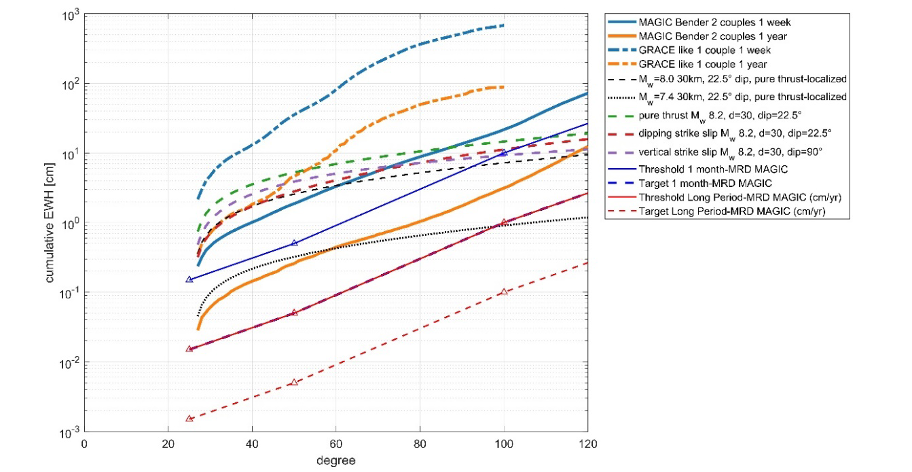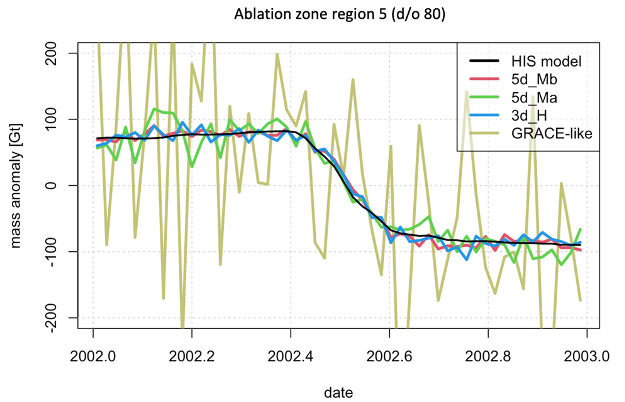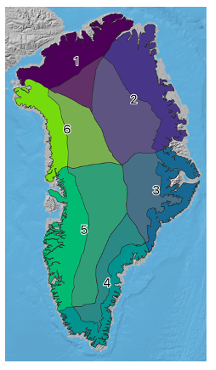Science impact analysis
The science impact analyses for the fields of hydrology, cryosphere, oceanography and solid Earth revealed significant added value of MAGIC constellations for unravelling and understanding mass transport and mass change processes in the Earth system. For hydrological applications, the number of hydrological units, e.g. river basins, that can be analyzed for water storage variations within the limits of MRD requirements will markedly increase compared to a GRACE-like mission. At a comparatively high spatial resolution, the threshold accuracy (10.1 cm at N=77) can be fulfilled by MAGIC for more than 90% of the river basins worldwide (compared to 2.5% with GRACE-type missions), and even higher accuracies that may be required for several hydrological applications can be met in a large number of basins (Figure 1). In contrast, the current MRD requirement at the lower spatial resolution of 400 km cannot be met by MAGIC for any river basin. However, relaxing this threshold accuracy to 2.5 cm or 3.5 cm, which can be expected to be still acceptable for many hydrological applications, will allow for resolving TWS variations in 67% and 90% (0.5% and 2.5% for GRACE-type missions) of the river basins, respectively. For the optimally filtered solutions, the improvement of MAGIC relative to GRACE in terms of RMSD errors of basin-average water storage variations worldwide amounts to a factor of 1.5 to 5, where the largest improvements occur for basin in low-latitude regions, which are hampered most by temporal aliasing errors.
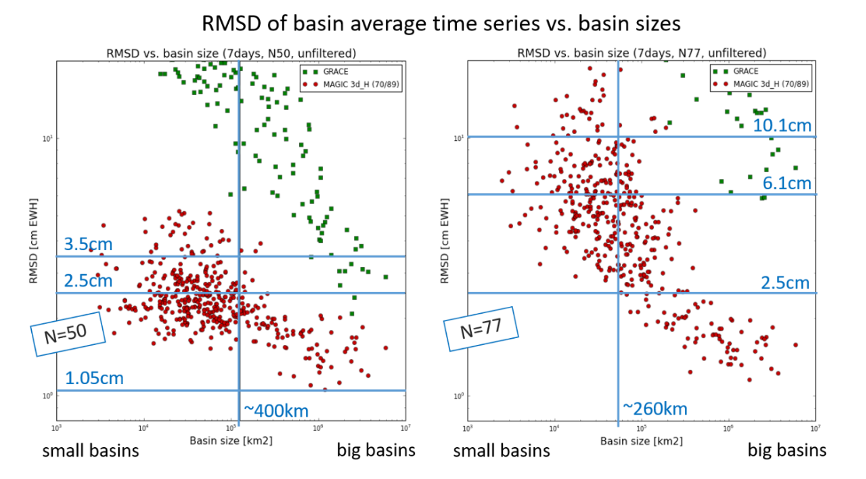
Climate change impacts on the global water cycle such as its intensification will be markedly better be observed by a MAGIC double pair mission than by a GRACE-like mission. While, according to our simulations, a GRACE-like mission can only detect the projected changes of the annual amplitude of continental water storage in 36% of the land area after 30 years of observation, MAGIC-like missions would be able to identify such changes in 64% of the land area (Figure 2). Similarly, the projected 30-years phase change of water storage can be detected by the single-pair scenario in 30% of the land area while a significant increase of this portion (56% of land area) can be achieved with the MAGIC constellation.
For cryosphere applications, our analysis shows that the double-pair MAGIC configurations will drastically improve our ability to monitor mass displacements on the ice sheets compared to what is currently possible. It is shown that it should be feasible to separate mass signals in the interior of Greenland or Antarctica from those in the coastal zones (Figure 3), which is of high scientific interest. While for the hydrology, ocean and solid Earth analyses the MAGIC 3d_H, 5d_Ma and 5d_Mb constellations performed very similar, the 5d_Mb configuration shows the best performance for the cryosphere applications, which is related to the lower altitude of the polar pair compared to scenario 3d_H, and the higher inclination of the inclined pair compared to scenario 5d_Ma. Correspondingly, scenario 5d_Mb shows the largest number of basins passing the threshold and target criteria and the lowest RMSE. At a 250 km resolution, the threshold accuracy for monthly time scales (5.5 cm RMSE) is met for 40 out of the 45 basins, and at daily-to-weekly time scales (6.3 cm RMSE) still for 37 basins. For the Antarctic Peninsula as a region of rapid ice loss, the added scientific value of a double-pair mission is far-reaching as the RMSE drops to an order of magnitude lower than what is currently achievable with a single-pair mission.
In the field of oceanography, the MAGIC double-pair configurations produce a dramatic improvement in ocean bottom pressure determination over the single pair GRACE-style configuration. While the present state GRACE measurements cover only the large-scale fluctuations over the range of degrees from about 5 to 15-30 which are of little climatic interest, the new configurations extend the valuable information out to degrees up to between degree 50 and 80, depending on the signal. This is a game-changing extension, permitting clear physical interpretation of aspects of the ocean circulation which are of most relevance to the Earth System, including the potential to monitor meridional overturning circulation changes on time scales of years and decades. The Caribbean Sea example shows a change from barely detectable signals (at about 1 cm RMS) to clearly detectable ones, increasing the explained variance from about 50% of the single-pair to 80%-90% with the double-pair configuration (Figure 4).
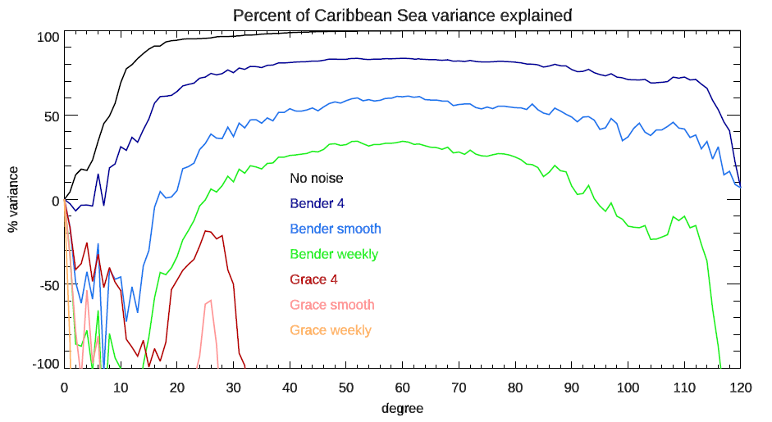
Our analysis of the MAGIC performance in detecting a gravity signal generated by an earthquake of a magnitude Mshows that it will bring a definitive improvement compared to the present observation technologies of a GRACE-like configuration. When comparing single and double pair configurations with weekly solutions, the double pair significantly lowers the detectable moment magnitude from M=8.8 to M=8.2, and increases the highest observable degree up to about 60 (333 km resolution). Lowering the time resolution to 1 year, the Bender configuration would detect earthquakes with magnitude M=7.4 upwards (Figure 5).
